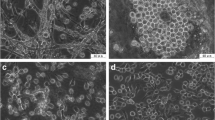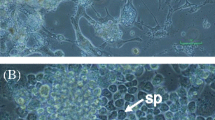Abstract
The first continuous cell line from the neonate larval tissues of Blaps rhynchoptera, which has been used as a folk medicine in Yunnan Province, China, was established and designated RIRI-BR1. This cell line was serially subcultured in Schneider’s medium supplemented with 15% fetal bovine serum (FBS). The cells grew adherent to culture flasks and exhibited spindle-like and polygonal shapes. The growth rate was determined at the 50th passage, and the population doubling time was calculated to be 79.5 h. The post-thaw viability of the cell line at different passages showed that the cells from higher passages could be recovered easier after cryopreservation than the cells from lower passages. The average chromosome numbers from cells of the RIRI-BR1 cell line at passages 5 to 50 ranged from 12 to 130. The rDNA internal transcribed spacer (ITS) sequence analysis indicated that the RIRI-BR1 cell line was derived from B. rhynchoptera.



Similar content being viewed by others
References
Asgari S, Johnson KN (2010) Insect virology. Caister Academic Press, Norfolk
Charpentier C, Tian L, Cossette J, Lery X (2002) Characterization of cell lines developed from the Colorado potato beetle, Leptinotarsa decemlineata Say (Coleoptera: Chrysomelidae). In Vitro Cell Dev Biol Anim 38:73–78
Chen YR, Solter LF, Chien TY, Jiang MH, Lin HF, Fan HS, Lo CF, Wang CH (2009) Characterization of a new insect cell line (NTU-YB) derived from the common grass yellow butterfly, Eurema hecabe (Linnaeus) (Pieridae: Lepidoptera) and its susceptibility to microsporidia. J Invertebr Pathol 102:256–262
Crawford AM (1982) A coleopteran cell line derived from Heteronychus arator (Coleoptera: Scarabaeidae). In Vitro 18(10):813–816
Goodman CL, Stanley D, Ringbaue JA Jr, Beeman RW, Silver K, Park Y (2012) A cell line derived from the red flour beetle Tribolium castaneum (Coleoptera: Tenebrionidae). In Vitro Cell Dev Biol Anim 48:426–433
Grace TDC (1962) Establishment of four strains of cells from insect tissues grown in vitro. Nature 195:788–789
Hayflick L (1973) Subculturing human diploid fibroblast cultures. In: Kurse PF, Patterson MK Jr (eds) Tissue culture: methods and applications. Academic, New York, pp 220–223
Hoshino K, Hirose M, Iwabuchi K (2009) A new insect cell line from the longicorn beetle Plagionotus christophi (Coleoptera: Cerambycidae). In Vitro Cell Dev Biol Anim 45:19–22
Iwabuchi K (1999) An established cell line from the beetle, Xylotrechus pyrrhoderus (Coleoptera: Cerambycidae). In Vitro Cell Dev Biol Anim 35:612–615
Long SH, McIntosh AH, Grasela JJ, Goodman CL (2002) The establishment of a Colorado potato beetle (Coleoptera: Chrysomelidae) pupal cell line. Appl Entomol Zool 37:447–450
Lynn DE (1995) A new insect cell line from the Colorado potato beetle. In Vitro Cell Dev Biol Anim 31:91–93
Lynn DE (2001) Novel techniques to establish new insect cell lines. In Vitro Cell Dev Biol Anim 37:319–321
Lynn DE (2007) Available lepidopteran insect cell lines. In: Murhammer DW (ed) Methods in molecular biology series. Baculovirus and insect cell expression protocols. Springer, New York, pp 117–144
Lynn DE, Stoppleworth A (1984) Established cell lines from the beetle, Diabrotica undecimpunctata (Coleoptera: Chrysomelidae). In Vitro 20(5):365–368
McIntosh AH, Grasela JJ (2009) Establishment of a monarch butterfly (Danaus plexippus, Lepidoptera: Danaidae) cell line and its susceptibility to insect viruses. Appl Entomol Zool 44(2):331–336
Mitsuhashi J (2002a) Invertebrate tissue culture methods. Springer, Tokyo, pp 118–120
Mitsuhashi J (2002b) Invertebrate tissue culture methods. Springer, Tokyo, pp 41–42
Mitsuhashi J (2002c) Invertebrate tissue culture methods. Springer, Tokyo, pp 321–324
Mitsuhashi J (2003) A continuous cell line from the cupreous chafer, Anomala cuprea Hope (Insecta, Coleoptera, Scarabaeidae). In Vitro Cell Dev Biol Anim 39:399–401
Murhammer DW (2007) Baculovirus and insect cell expression protocols, 2nd edn. Humana Press Inc., Totowa, p 460
Peel AD (2009) Forward genetics in Tribolium castaneum: opening new avenues of research in arthropod biology. J Biol 8(106):1–4
Sahara K, Marec F, Traut W (1999) TTAGG telomeric repeats in chromosomes of some insects and other arthropods. Chromosome Res 7(6):449–460
Schneider I (1972) Cell lines derived from late embryonic stages of Drosophila melanogaster. Embryol Exp Morpholog 27(2):353–365
Schröder R, Beermann A, Wittkopp N, Lutz R (2008) From development to biodiversity—Tribolium castaneum, an insect model organism for short germband development. Dev Genes Evol 218:119–126
Smagghe G, Goodman CL, Stanley D (2009) Insect cell culture and applications to research and pest management. In Vitro Cell Dev Biol Anim 45:93–105
Stiles B, McDonald IC, Gerst JW, Adams TS, Newman SM (1992) Initiation and characterization of five embryonic cell lines from the cotton boll weevil Anthonomus grandis in a commercial serum-free medium. In Vitro Cell Dev Biol Anim 28:355–363
Sun L, Feng Y, He Z, Chen ZY, Zhao M, He R (2012) Isolation and comparison of jnhibitory effect of antimicrobial peptides from Blaps rhynchoptera larvae under induced and non-induced conditions. For Res 25(3):373–377
Zhang X, Feng Y, Ding WF, Chen XM, Wang CY, Ma T (2011) Establishment and characterization of an embryonic cell line from Gampsocleis gratiosa (Orthoptera: Tettigoniidae). In Vitro Cell Dev Biol Anim 47(4):327–332
Zhao M, Feng Y, Chen XM, Ji HH (2009) Morphological and biological characteristics of Blaps rhynchoptera Fairmaire (Coleoptera: Tenebrionidae). J Environ Entomol 31(4):348–355
Acknowledgments
This work was supported by grants from the National Ministry of Forestry of China (No. 2013-4-53) and the Chinese Academy of Forestry (No. riricaf2012002M).
Author information
Authors and Affiliations
Corresponding author
Additional information
Editor: T. Okamoto
Rights and permissions
About this article
Cite this article
Zhang, X., Feng, Y., Ding, WF. et al. A new continuous cell line from Blaps rhynchoptera Fairmaire (Coleoptera: Tenebrionidae). In Vitro Cell.Dev.Biol.-Animal 51, 151–156 (2015). https://doi.org/10.1007/s11626-014-9815-5
Received:
Accepted:
Published:
Issue Date:
DOI: https://doi.org/10.1007/s11626-014-9815-5




